Planning your trip yourself will always lead to a trip that is much more enjoyable — and much more affordable too, of course. As part of your preparation for ALL trips, checking the countries’ entry requirements is really a very basic and essential step.
In fact, it’s literally the only step that’s mandatory when you want to go to any country: checking what the country’s entry requirements are. That’s pretty much it, the rest is just details.
(You can download our free ebook with 100+ travel tips if you want to learn!)
Many people don’t know that you have to check a country’s entry requirements, which is a bit surprising to us. But then again, of course, when you just don’t know, you can’t know (as with so many simple travel tips), so we’re all about helping you be a travel pro… and this is one that’s really very basic.
Here’s the introduction to countries’ entry requirements, or travel rules (we’ll have more content soon, but I want to at least remind you of the basics for those who might not be as experienced).
(We often get requests for more content for those who are less experienced in travel planning — we often take many things for granted and assume they’re obvious because we’re so experienced — so here is one and stay tuned for more!)
Overview of countries’ entry requirements for travelers
Here’s the overview in 3 brief sections:
- What to know about the basics of entry requirements
- How to check entry requirements
- What kind of entry requirements exist
What to know about the basics of entry requirements
You always need to check the entry requirements of each country, always.
Simple as that. Unless, you’ve already been there and know the rules, of course. And even then, some countries might have changed their rules, even if it’s pretty rare. For example, 30 European countries will start requiring what is essentially an e-visa in 2025.
You have to check for transits too… you’re going to that country, so you have to check.
Often there are no requirements… but check!
(Many travelers seem to have completely discovered the concept of entry requirements during the COVID-19 pandemic with all the special restrictions governments imposed… but the concept of having requirements was nothing new though. You always had to check, and you always will have to check. Otherwise, the alternative is to stay at home, but that life is a lot less interesting 😉)
How to check entry requirements
In practical terms, there are several possible options for checking the entry requirements of a country:
- Flytrippers website (coming soon)
- Official country websites
- Government of Canada website
- Airline websites
- Official centralized database
I’ll explain them right below. But it’s really nothing complicated. Like everything else in the world of travel, you just have to:
- Know where to check
- Take the time to check
What kind of entry requirements exist
There are several types of entry requirements that countries can impose (I detail them all below):
- Visa, e-visa, or travel authorization
- Passport valid for 3 or 6 months
- Passport with a minimum number of empty pages
- Passport without specific country stamps
- Proof of exit from the country (proof of onward travel)
- Proof of accommodation
- Proof of sufficient funds
- Proof of insurance
- Vaccines
Most countries have very few requirements, or none at all (especially for those of us privileged to have a powerful Canadian passport). But the only way to find out what the requirements are in the country you’re going to… is to check.
Many people seem surprised to learn that you can’t enter many countries with a passport that expires within 6 months, or that some countries require proof of exit. But those are very common requirements!
For example, as mentioned, most European countries will require a pre-filled travel authorization for all Canadians as early as 2025 — our writer Emily, who is European, is doing an article on this for you and it will be published very soon. Also, Brazil will reinstate a visa requirement in April 2025.
So as I was saying, you always need to check because:
- Rules can change (even though it’s rare)
- Even “popular” countries have rules (it’s not just obscure countries)
Details of how to check countries’ entry requirements
Here’s how to get this part of the trip planning right.
Entry requirements — Checking the Flytrippers website (coming soon)
I just want to let you know that we’ll soon be launching a page with specific rules for Canadian travelers, for all the popular countries to start with, and all the countries in the world eventually.
We want to make it simple and easy to consult, which government sites don’t necessarily always do well, since they’re written by bureaucrats and civil servants. It’s especially true for entry requirements.
Coming soon.
You can sign up for our free newsletter to join 100,000+ savvy travelers who receive content to travel for less.
Entry requirements — Checking official country websites
Ideally, you should consult the official government website or the official tourism office website of the country in question (not a travel agency, travel blog, or anything like that).
It’s really their requirements, so as always, go straight to the source if you want the most reliable and up-to-date information.
But that’s not always easy to find for all countries. They are governments after all, so making things efficient, simple, and useful isn’t their specialty.
Entry requirements — Checking the Government of Canada website
To easily get all the countries in one place, the Government of Canada’s travel site can be a good reference for that. Not for the overly alarmist travel advisories, as we’ve often told you.
Anyway, for once the government is helpful, you can check each country’s entry requirements specifically for Canadians. It’s often clearer than on official country websites (depending on the country) and it’s definitely easier to find, since it’s all on the same site.
Select the country from the drop-down menu and click on “Go!”.
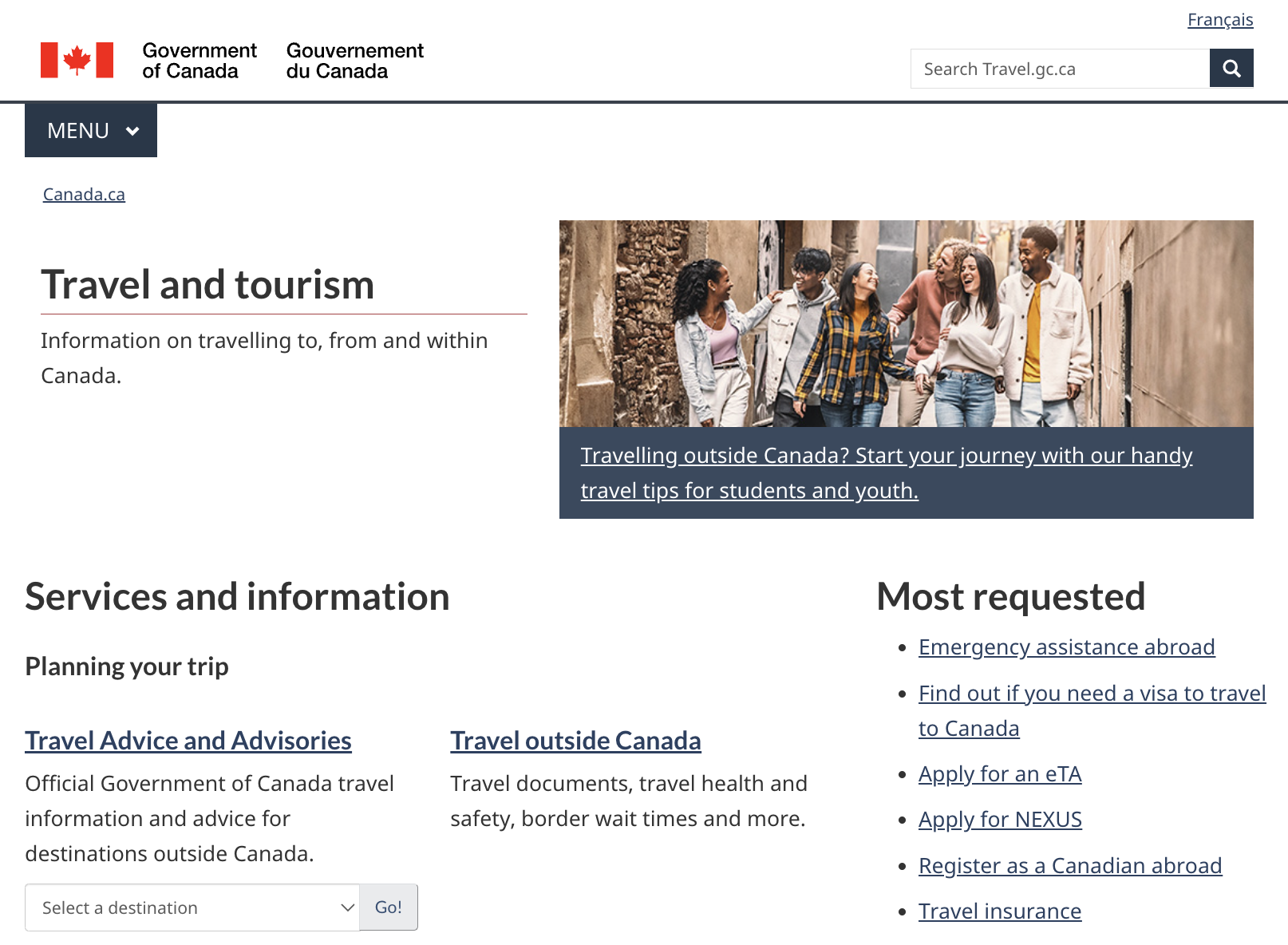
Then you stop being afraid of everything, and don’t take everything written about risks at face value (that’s also very basic; we’ll be doing an updated article about that soon).
You go directly to the “Entry and exit requirements” section in the table of contents at the top.
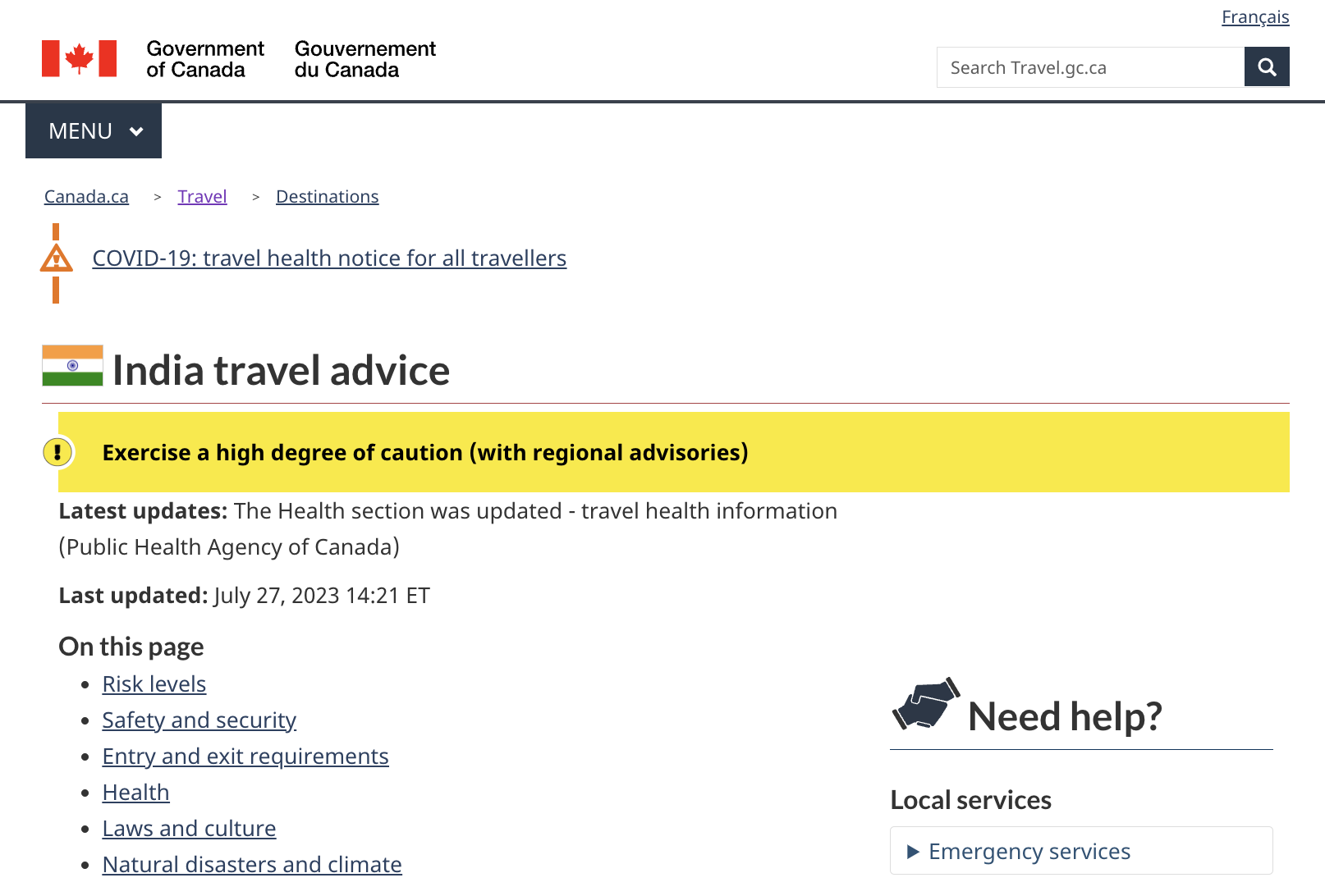
And you’ll see all the requirements for the country.
Then you read.
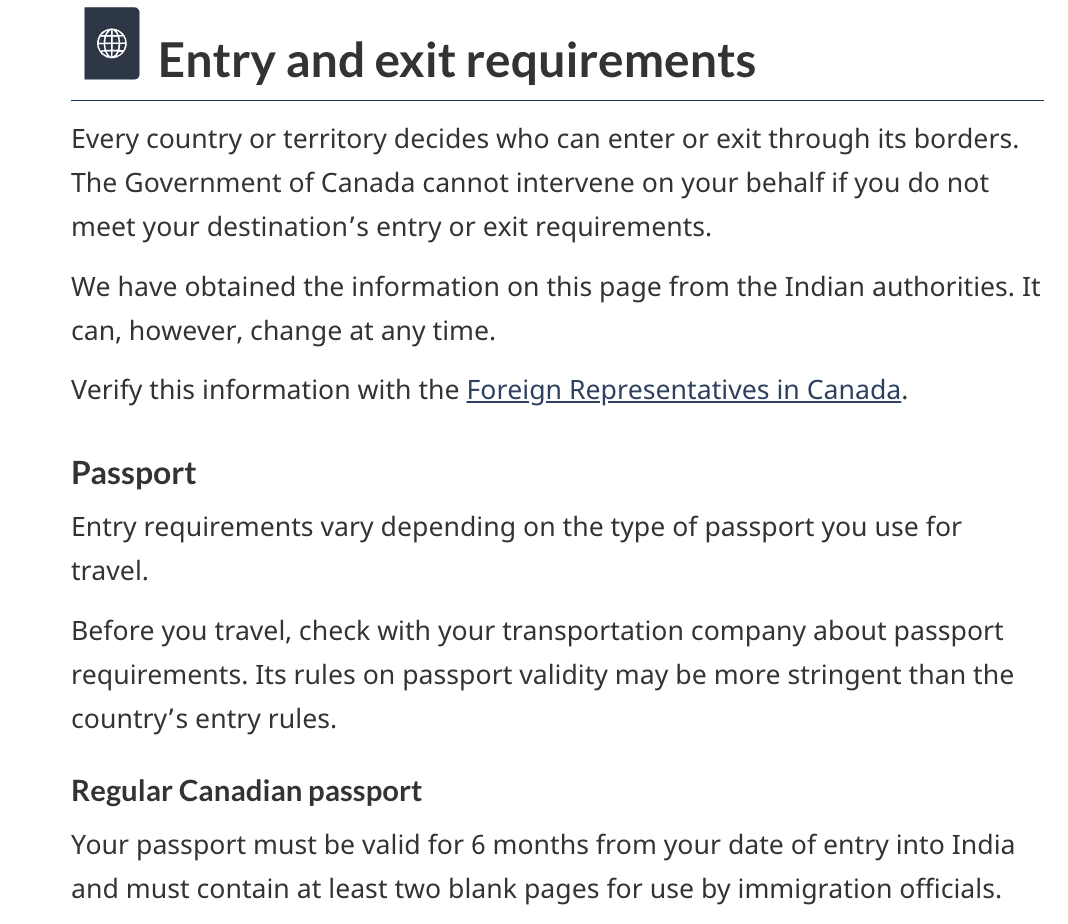
Entry requirements — Checking airline websites
Note that logistically, entry requirements will often be enforced by the airline at the very beginning of your itinerary, not just on arrival in the country in question (but even then, they are sometimes also enforced on arrival in the country too).
Too few people realize that it’s at the initial point of departure that the rules must be respected. For example, if the final destination asks for proof of exit, no, you can’t book that during your layover: the airline will usually check at the very beginning of your journey.
If, like us, you had the good fortune to travel quite a bit during the pandemic to get out of the nightmare that was Canada, you would definitely have understood that there are 2 very different things in the world of travel rules:
- The rules
- The interpretation and application of the rules by the airlines
But it’s not as bad for normal entry requirements (compared to the terrible COVID-19 rules).
Still, it’s always obviously the airline that decides whether you board or not. So it’s always a good idea to use their own tool to check requirements.
Personally, I use the one from Qatar Airways (but the airlines all use the same official database from the next section).
Not the first tool, but the 2nd below. It gives you the essential info.
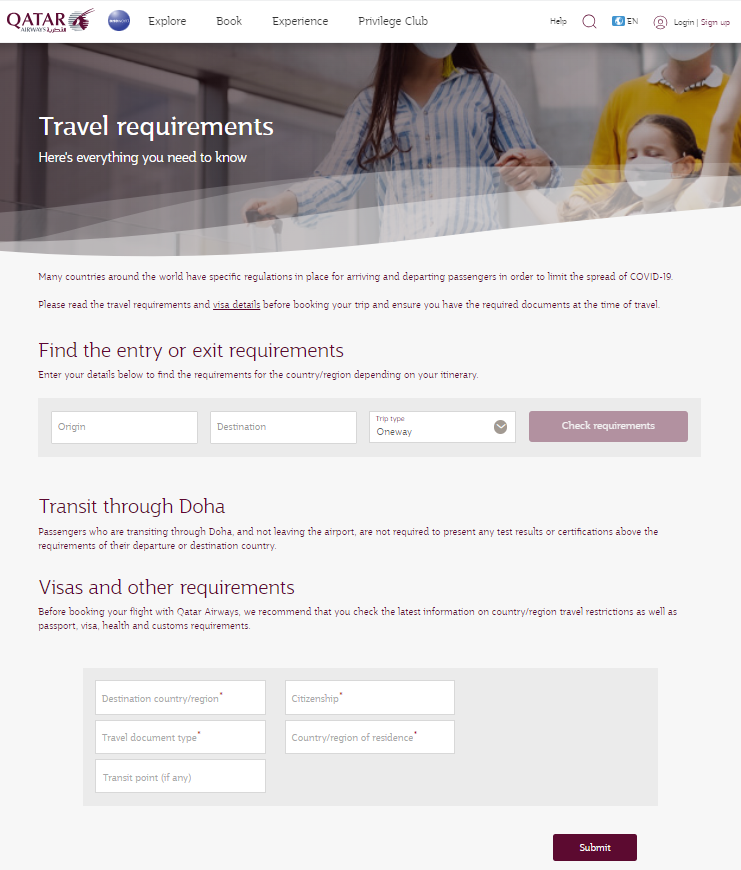
Entry requirements — Checking on the official centralized database
All airlines use the IATA database, which you can access directly from the IATA website.
However, this site is less user-friendly because you have to enter a lot of information just to access the requirements, so it’s a bit longer than on the previous Qatar Airways site.
But it’s really the official database if you want to check there.
First you have to select the country and click “Check”.
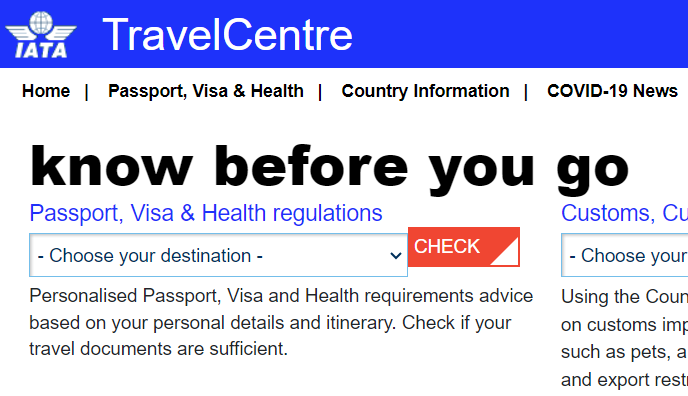
You then have to fill in a lot of information, but that means they give you the most precise requirements possible.
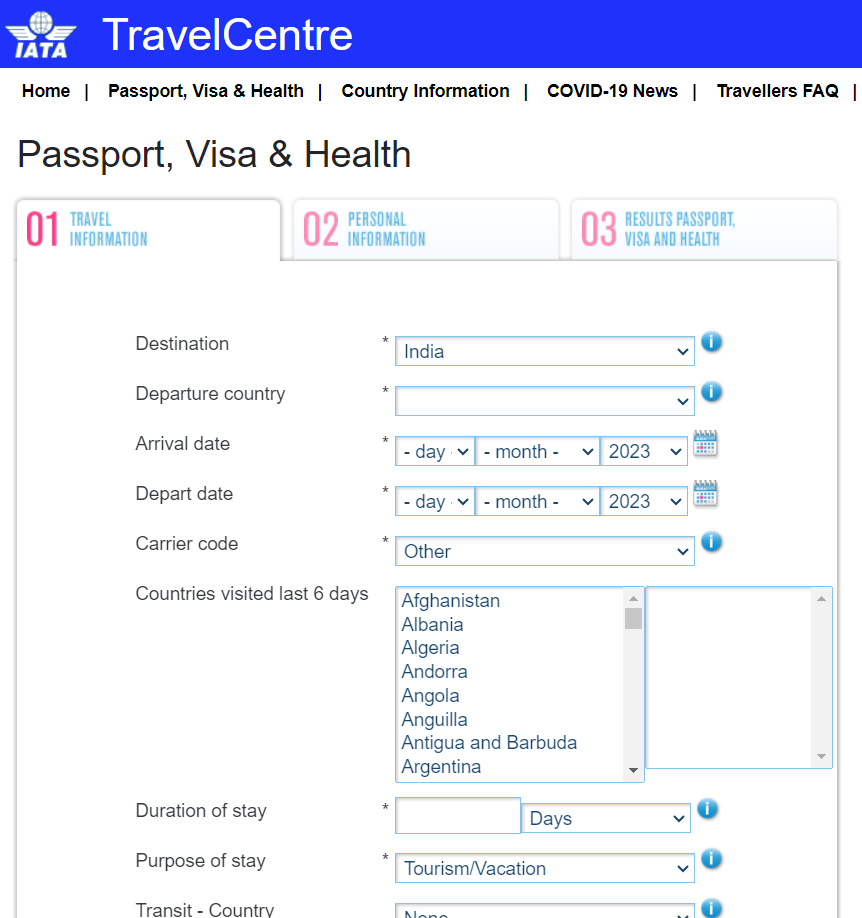
Details of countries’ entry requirements
Here’s an introduction to each type of entry requirement.
Here are the basics of the visa, e-visa, or travel authorization requirements:
- You need an authorization to enter the country
- Very common requirement
Here are more details on visa, e-visa, or travel authorization requirements:
- The visa is the name of the document required to enter the country
- Sometimes a visa on arrival is available
- But usually you have to get it before your flight
- An e-visa is the same thing, but 100% online
- A travel authorization is the same thing, but 100% online
- Sometimes a visa is required even for transits
- Sometimes there’s a delay before you receive your visa
- Always go through the official government website
- Lots of people get caught paying more on the wrong site
- It’s always cheaper to complete the application yourself
- If you need support, we recommend iVisa
- Visa prices vary widely
- Visa duration varies widely
- The number of different entries allowed varies
- Sometimes there are additional requirements
- Sometimes you have to carry a printed version of the visa with you
Examples of countries requiring visas, e-visas, and authorizations:
- India
- China
- Egypt since September 2023
- Brazil starting in April 2025
- 30 countries in Europe starting in 2025
It’s the most common entry requirement. Many countries still require this. The traditional visa that you can’t get online isn’t as common, fortunately. But there are some. Otherwise, when it’s an e-visa or online travel authorization, it’s very easy to do.
When it’s a visa on arrival, it’s even easier because you don’t need to do anything beforehand. But often, you can still do it in advance — and you should, to save precious time in the country and get out of the airport faster to explore the destination.
Most of the time, you have to do everything in advance. When it’s an e-visa, it’s as easy as filling in any online form. Often it’s just a formality and just a more complicated way of taxing visitors.
Several European countries are about to implement an electronic travel authorization in 2025, but even if the word visa doesn’t appear, come on… it’s pretty much the same thing as an e-visa quite simply. So I can confidently predict that plenty of people will wake up on the day of their flight to Europe and be really surprised that in life, you need to look at the entry requirements when you travel!
Depending on the type of visa, you may need to request it a certain number of days in advance. It’s not always instantaneous. Be on top of your things.
Logistically, it’s fascinating how many people are fooled by all the random sites that try to pass themselves off as official government sites (notably by buying the placements at the top of the Google results page for when you search for the country’s visa).
Just make sure it’s the official government site, so you don’t pay more for absolutely nothing.
Unless you’d like some guidance in completing the visa application (which really shouldn’t be necessary, to be honest). In that case, the most reputable site we recommend is iVisa.
Visa prices vary, and some can be quite expensive, so it’s something to check even at the very beginning of your reflection on destination choices (if you’re interested in traveling for less; including to be able to travel more).
Sometimes you have to literally go to an embassy or consulate in person. And provide an official passport photo. But usually it’s just a matter of filling out a simple form.
Sometimes visas are valid for 10 years, sometimes for 30 days. Sometimes it’s up to you to decide based on your needs. Some allow multiple entries, others a single entry, and others a specific number of entries.
Sometimes the visa only allows you to enter by air. Sometimes visa requirements may differ depending on the mode of entry.
Sometimes you need an actual local guide to accompany you all along your trip at a high cost, or someone to officially invite you into the country. It’s rare, but there are countries like that, unfortunately.
Finally, check whether the digital proof is sufficient (often the case), because some countries still think it’s 2010 and demand the printed version.
Entry requirements — Passports valid for 3 or 6 months
Here are the basics of the requirement for passports with 3 or 6 months of validity:
- You must have a passport that does not expire within 3 or 6 months
- Very common requirement
Here are more details on the requirement for passports with 3 or 6 months validity:
- It’s 3 or 6 months from your arrival date or planned departure date
Examples of countries that require a passport with 3 or 6 months validity:
- France
- Greece
- Germany
- Thailand
- Dozens of other countries
This one is also very common. I was honestly surprised to realize how few people know this, I thought it was more widely known.
But in fact, it would be quite logical to think that the fact that your passport has an explicit expiry date should mean that you can use it until the expiry date. But no.
It’s very logical that some countries have this rule: they don’t want to be stuck with you. Many countries don’t want you to be stuck in their country without a travel document to get out of their territory, in case you extend your trip for any reason whatsoever. So they have a buffer of 3 or 6 months (or even 45 days in some countries).
So, once again, do your homework and don’t wait 7 months before your passport expires to renew it. You’ve seen the legendary efficiency and reliability of federal government services in Canada (and if you’re just joining us on this planet, you should know about it now).
So it really doesn’t make sense to wait until the last minute. It’s not rocket science. It’s part of trip planning. Know your passport expiry date, and be proactive.
I don’t want to be mean, but it’s so easy to travel better and to travel for less: you just need to invest time into planning your trips right. Really that simple! It’s 1 of the top 7 most important tips in our free ebook with 100+ travel tips!
Entry requirements — Passports with a minimum number of blank pages
Here are the basics of the requirement for passports with a minimum number of blank pages:
- You must have at least 1 or 2 (sometimes 6) completely empty pages in your passport
- Rarer requirement
Here are more details on the requirement for passports with a minimum number of blank pages:
- They can refuse entry if you don’t have the required blank pages
Examples of countries that require a passport with a minimum of empty pages:
- United Kingdom
- Germany
- Morocco
Of course, for the average traveler, who unfortunately only travels 3-4 times a year, it’s really not an issue. But for someone like me, who had to renew my last passport well before 5 years because it was completely full, it can be problematic.
There are honestly very few countries that require this (and I’m far from convinced that they really do enforce this), but if the requirement exists and you’re denied entry, it’s really you who’s in the wrong.
Entry requirements — Passports without specific country stamp
Here are the basics of the requirement for passports without a specific country stamp:
- You must have a passport that does not have a stamp from certain countries
- Very rare requirement
Here are more details on the requirement for passports without a specific country stamp:
- You also can’t tell them if you’ve been to the country in question
- They cannot know if you don’t tell them and don’t have a stamp
Examples of countries that require a passport without a specific country stamp:
- Lebanon
- Other countries in the Arab world
Another fairly rare requirement, but the best-known example, is due to political disputes in the Middle East.
Several Arab countries have a requirement not to have been to Israel. The country has decided to stop stamping passports for ordinary tourists, so it’s not really a passport issue anymore. But it’s important to know about the requirement if the customs officers ask about it.
When I went to Lebanon, if I had told the customs officers that I had visited Israel, I would have been denied entry. So again, it’s not an issue if you’re on top of your things and know that you cannot tell them. That’s why it’s important to check the rules, once again.
They can’t know you’ve been there if you don’t have anything in your passport that says you’ve been there and you don’t tell them you’ve been there. They could obviously scour your social media, but that’s pretty extreme and really isn’t common.
Entry requirements — Proof of exit (proof of onward travel)
Here are the basics of the requirement for proof of exit/proof of onward travel:
- You must have a plane ticket to leave the country
- A fairly common requirement
Here are more details on the requirement for proof of exit/proof of onward travel:
- It can be a completely separate ticket, of course
- It can be to anywhere (not just your own country)
- You’ll be denied boarding if it’s required and you don’t have it
- There are easy ways to get proof of exit for free (don’t pay for that)
Examples of countries requiring proof of exit from the country:
- Costa Rica
- India
- Indonesia
- Several other countries
This entry requirement is relatively common, and it’s another one I thought everyone knew about. In short, some countries will ask you to prove that you’re leaving.
Most people unfortunately always buy roundtrip plane tickets that are very simple (which are very often more expensive), so it doesn’t affect them.
But if you book your own itinerary with self-transfers, visit several countries consecutively, or just buy a one-way ticket, you may not have proof of exit.
It’s less serious in this case, because at worst you can sort it out instantly when they ask you if you didn’t know (by booking a ticket on your mobile phone).
If you don’t want to decide on your itinerary right away, there are 3 simple solutions in these situations (and no, it’s most definitely not to unnecessarily pay for a service that creates a false proof of exit for you or rents you a plane ticket):
- Buy a plane ticket on a USA airline that is refundable free of charge for 24 hours
- Buy a ticket in a fully refundable fare class
- Buy a refundable train or bus ticket (but sometimes they really do require a plane ticket)
Once you’ve cleared customs, you can simply get a refund on your refundable ticket. Make sure you pay with a credit card that doesn’t charge you the 2.5% foreign transaction fee so that it’s completely free, or book in Canadian dollars on an airline website that offers that.
Entry requirements — Proof of accommodation
Here are the basics of the requirement for proof of accommodation:
- You must have proof of accommodation booked in the country
- Very rare requirement
Here are more details on the requirement for proof of accommodation:
- Either proof for just the 1st night
- Or for the entire stay
- There’s a way to get this for free
Examples of countries requiring proof of accommodation:
- A few countries
It’s very unusual, but some governments like to micromanage what you do with your life. They’ll ask you for proof that you’ve booked accommodation.
If that’s the case, you won’t have much choice but to book at least one night. Sometimes just that first night is enough proof.
On the other hand, almost all hotels are fully refundable as long as you cancel at least one day in advance (but some hotels require more than just 1 day’s notice, always double-check).
So if they want proof for the whole stay but you’re like us and want the flexibility to wait before choosing your accommodations and your itinerary in the country, you can book a separate hotel (which is refundable) for the whole stay starting from the 2nd night to show the customs agent. And cancel it as soon as you clear customs and then decide where you want to go later.
Entry requirements — Proof of sufficient funds
Here are the basics of the requirement for proof of sufficient funds:
- You must have proof of having enough money for your trip
- Extremely rare requirement (never happened in 70+ countries personally)
Here are more details on the requirement for proof of sufficient funds:
- They want to be sure you have enough money to support yourself
- This can often be cash or a bank account balance
Examples of countries requiring proof of sufficient funds:
- A few rare countries
It’s really very rare, but that’s why you have to read the requirements and be prepared to show proof of funds if it’s something they ask for.
Entry requirements — Proof of insurance
Here are the basics of the requirement for proof of insurance:
- You must have proof of travel insurance
- Very rare requirement
Here are more details on the requirement for proof of insurance:
- It’s only emergency medical care insurance, not other types of insurance
- They want to see that you’ll be able to pay if you need healthcare
- Proof of coverage is all you need (like your credit card insurance certificate)
Examples of countries requiring proof of insurance:
- A few rare countries
Another very rare requirement, but you should never travel without travel insurance for medical care anyway, it’s just not very savvy.
Plenty of credit cards cover you for free (better than free: you get hundreds of dollars in free travel with welcome bonuses). Contrary to common myth, you don’t even have to pay for your trip with the card (most people know nothing about credit cards, even if they think they do; it’s a very counterintuitive world).
And if not, we have a few recommendations for really inexpensive travel insurance:
- SafetyWing (the least expensive)
- soNomad (the least expensive Canadian insurer)
It’s very insignificant in terms of amount compared to $100,000 in medical costs, and it can quickly add up to amounts like that (especially in the U.S…. but in other countries too). You can read our introduction to the health aspect of traveling.
Entry requirements — Vaccines
Here are the basics of the requirement for vaccines:
- You must have proof of vaccination
- There are a few types of vaccinations that may be required
- A relatively common requirement
Here are more details on the requirement for vaccines:
- Not to be confused with vaccines that are recommended but not mandatory
- It’s often the yellow fever vaccination that’s required in particular
- Especially in African countries
- Elsewhere, it’s often required if you’ve been to certain high-risk countries before
Examples of countries/territories requiring vaccines:
- French Guiana
- Ghana
- Rwanda
The vaccination requirement was very well known during the COVID-19 pandemic, but thankfully pretty much every country has gotten over that finally.
So it’s mainly the yellow fever vaccine that’s required. It’s a vaccine that’s good for life so any frequent traveler should consider it. I’ll have a promo code to save money soon if you’re in Ontario or Québec.
Many African countries require proof of yellow fever vaccination. Many other countries all around the world require it if you’ve recently been to countries considered to be high risk for yellow fever, and that list can include some pretty popular countries.
For example, I went to India last summer, and at first I thought the requirement applied because India considers Colombia to be high-risk (and I had been to Colombia a few months before). But it turns out India only requires this vaccine for those who had been to these countries very recently.
The timespan (and the list of countries that are high risk) will obviously vary for all countries, just as all rules always vary for all countries obviously, because they are different countries.
That’s why you need to just simply check the entry requirements every time.







